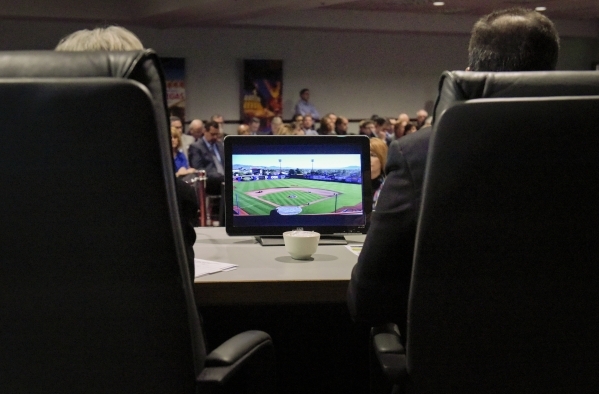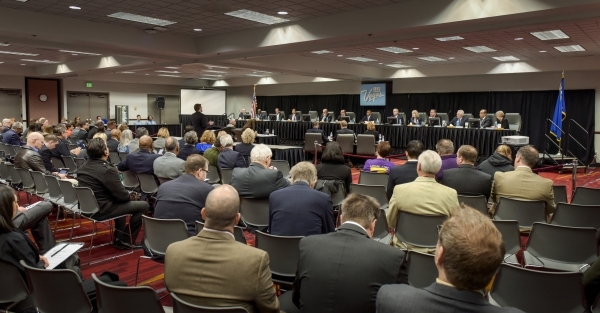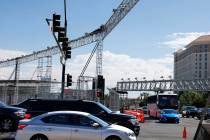Strip seen as prime territory for light-rail transit
The Strip is a prime location for a light-rail system because farebox revenue generated by the system would likely pay for operation and maintenance as well as some of the cost of building it.
David Swallow, a senior director with the Regional Transportation Commission of Southern Nevada, told the Las Vegas Convention and Visitors Authority board of directors Tuesday that bus fares from routes along the Strip represent about 34 percent of all transit revenue and that the Strip line far outperforms most public transit systems.
On Tuesday, the LVCVA board got its first look at the Regional Transportation Commission's Transportation Investment Business Plan. Similar presentations are planned before city, county and state groups that ultimately would have the responsibility of approving projects envisioned in the plan.
One of the key projects is linking McCarran International Airport with downtown Las Vegas via the Strip.
Swallow told the board that 40,000 riders — roughly 23 percent of the daily ridership on the entire system — ride buses along the Strip every day.
Swallow said in the United States, transit farebox pays about 27 percent of the operational costs of a system on average. In Southern Nevada, it pays about 50 percent of costs.
But if the Strip is broken out separately, farebox revenue provides 163 percent of operational costs.
Because of high demand expected between the airport, the Strip and downtown and the relatively short distance of the route, Swallow said it's possible that light-rail farebox revenue could pay for annual maintenance of a system as well as some of the cost of building the system.
Swallow also outlined some of the plan's proposals for pedestrian safety improvements, including seven new pedestrian overpasses along the Strip and a series of elevated sidewalks to minimize pedestrian-vehicle conflicts.
Transportation Commission General Manager Tina Quigley told the board that one of her top priorities that would have minimal cost would be the formation of a resort corridor mobility association to advise public bodies about needed improvements. The association would also note large conventions and special events and how street construction projects would affect them.
In other business, the board approved an executive restructuring proposal that is a part of a five-year vision plan.
Under the plan, which would add $1.1 million to next year's budget, four executive-level positions would be created under CEO Rossi Ralenkotter. The staff structure will include a chief operating officer handling day-to-day operations of the organization, a chief financial officer, a chief human resources officer and a chief communications and public affairs officer.
Only one of those position was filled in the board's unanimous vote of approval. Rana Lacer, senior vice president of finance, will be promoted to chief financial officer.
Nationwide searches are expected to be conducted for the other C-level positions. The authority has senior vice presidents that head facilities and marketing and the organization's senior vice president for human resources, Mark Olson, retired last month.
Ralenkotter said now that the board has approved restructuring plan, he would work in the months ahead to fill the positions.
The restructuring plan, developed through recommendations by consultant Clare Maher, a partner with High Lantern Group of Los Angeles, was part of a five-year vision plan that includes philosophical strategies that will guide the authority's mission.
The vision plan includes strategies to drive visitation, expand and improve the Las Vegas Convention Center and to improve the authority's financial viability.
Many of the strategies are similar to ideas that already are in place: growing convention and trade show attendance through expanded trade missions, hosting travel professionals, recruiting new international air service and implementing digital marketing tools for international offices.
The plan also includes launching a China Ready marketing program specifically to attract business from China.
The authority also looks to exploit the Las Vegas brand by identifying key markets, expanding website presentations and expanding the digital presence of the "What Happens Here, Stays Here" theme.
A key part of the plan is improving local facilities, which would include demolishing the Riviera and getting the 26 acres there ready for outdoor exhibits, upgrading Wi-Fi systems, developing "smart parking" lots noting open spaces.
LVCVA board chairman Lawrence Weekly, a Clark County commissioner, said the facility itself has become one of the city's weakest features.
"The convention center headquarters does not match up to the hype of the destination," Weekly said. "The connectivity is not good. When I toured the CES trade show floor (with top consumer electronics CEOs and dignitaries), there were people sitting on the floor. Visually, it's not a good look and we have to do something about it."
The LVCVA also hopes to strengthen its advocacy position and protect its primary source of revenue — taxes collected on hotel and motel rooms. In recent years, other state entities have successfully diverted some of that revenue to other programs.
The authority will get a boost in revenue later this year when facility rental rates will increase July 1 from 29 cents to 33 cents a square foot. Under action taken last year, the rate will increase again to 35 cents a square foot on July 1, 2018.
Contact reporter Richard N. Velotta at rvelotta@reviewjournal.com or 702-477-3893. Follow @RickVelotta on Twitter.


















